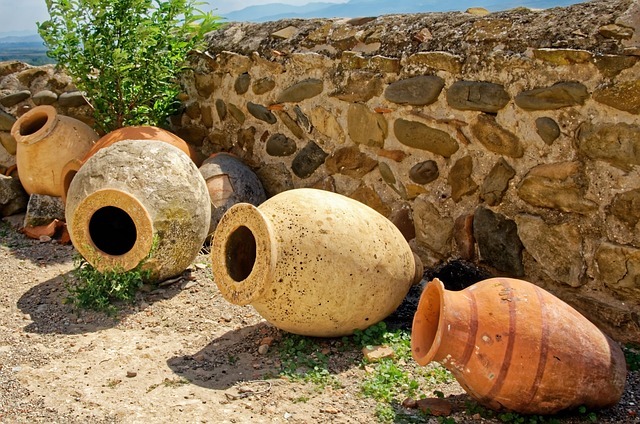Bible Lands Museum Part 2
Preface
The following was written by tour guide students on their first visit to the museum several years ago and may include criticisms that reflected that initial experience. It should be pointed out that the museum has undergone many changes and personally as a qualified tour guide who was among those earlier students, I would have no hesitation recommending this wonderful museum,
The collection, being composed of items purchased on the open market, has been severely criticized. It was claimed that any such artifacts were stolen from archaeological sites and cannot therefore be placed with certainty at any specific location or dated by stratigraphy or by proximity to other datable artifacts. As such, the collection, it was claimed, was worthless to archaeologists and was condemned as serving only to promote the continued looting of archaeological sites. Although there are undoubtedly problems of attribution of items of the collection, it remains an excellent teaching tool, and an inspiration to those of callings lower than the professional archaeologist who are drawn to the Biblical narrative and the artifacts that have an association with it. Closing of the BLMJ will have no noticeable effect on the public’s hunger for ancient artifacts and the looting of sites to feed that hunger, but the closing of the BLMJ would be a devastating loss to the general public.
A related criticism is that the presentation of the collection specifically for viewing the Bible through items of the material culture of the lands neighboring Eretz Israel is contrived and is not respectful of the items themselves. An Assyrian scribe, for instance, had no knowledge of a Biblical narrative, but his work should be of interest for its own sake, not as a witness to Biblical history. The scrupulously trilingual (Hebrew, Arabic, English) headings over each display case present Biblical passages, even where the connection to the items on display is strained at best.
The Museum is, according to some, a difficult place in which to guide groups. As just mentioned, being a “Bible Lands Museum”, each artifact has been forced, sometimes rather awkwardly into a relationship to the Biblical narrative. Advice to prospective guides, therefore, is:
Choose carefully which groups are brought to the Museum. Those with a special interest in Biblical archaeology will be most appreciative of the collection. The Museum may not be appropriate for a mixed group paying their first visit to Israel.
Choose about 10 items from the collection to explain in detail. Begin with the big map in the Introductory Gallery; show the extent of the various empires that contested the area, and their historical sequence. Select, for instance, one cylinder seal, one example of writing, one Egyptian item, one Hittite item, etc. Then give the group free time to explore the collection on their own.
Visit the Museum early in the day, while visitors can give the collection the concentration it deserves.
The Museum is not a crowded place. The peacefulness is welcome, but the quiet betrays a sad neglect by local and foreign tourists. However, the BLMJ has an extensive education program through schools and special holiday programs for children. The excellent web site, www.blmj.org, offers a history of the collection, lists of up-coming lectures, concerts and events, a virtual tour of
the collection and a sampling of the gift shop’s offerings.
APPENDIX
At the BLMJ, Dr. Horowitz continued his lectures on Biblical history in the context of the cultures of the Near East.
Biblical history becomes historical, i.e. a scholarly and secular subject, with the first extant extra-Biblical references to Israel. These are the reference on the Marneptah stele (~1220 BCE) in which Israel is mentioned as one of the defeated allies of the Sea Peoples, the Beit David stele from Dan or with Senacharib’s campaign against Jerusalem (701 BCE). To those who are committed to the proposition that there was no ancient Jewish presence in Eretz Israel, no documentation will be found acceptable.
At the time of the Judges, the Twelve Tribes were located in the hill country of what is now Samaria and Judah. The Tribes had strong affinities among them, and as was common at the time, such affinities were read back into history as a familial relationship of the founding members of the groups. At this time, the Philistines five cities, Ashkelon, Ashdod, Gaza, Gat and Ekron, were located along the Via Maris on the southern coastal plain, but in the absence of a strong Egypt at that time, they seem to have taken over the Egyptian garrison towns, such as Beit-She’an, far from their area of residence. The Philistines posed a strong military challenge to the Tribes, and in response, they petitioned Samuel, their acknowledged religious leader, for a king (Sam. I, 8). Against his advice, they insisted on a king, and period of the united monarchy begins with the anointing of Saul (1030?-1009 BCE) from the Tribe of Benjamin. Clearly, Saul was an unsuccessful leader, as in the last battle of his reign, in which he was killed, was staged at Gilboa (Sam. I, 31), much closer to the Israelite centers than the Philistines’ Five Cities. David, from the Tribe of Judah, before his self-imposed exile from Saul’s court, was a hero of the wars against the Philistines, and was acclaimed king in Hebron ca. 1009 BCE.
David (ca. 1009 to 969 BCE) has historically been Israel’s ideal king. His career may be compared with the Near Eastern paradigm of an ideal king, who must extend the area of his control to the natural borders of his area. The Mesopotamian kings felt it their Manifest Destiny to rule the entire world, but David’s mandate was the lands promised to Abraham, from the Euphrates to the River of Egypt (Gen. 15, 18), i.e. from the upper Euphrates to the Sinai Desert, the middle territory between the centers of Mesopotamian and Egyptian power. Sam. II, 8, 3 refers to David establishing yado (his hand, or better, his monument) at the Euphrates. It was a common practice in the Near East of that time for a military commander to erect a stele or carve a celebratory inscription on a cliffside at the furthest extent of a military expedition, and in transition from the Late Bronze Age to the Iron Age, when the Babylonians and Egyptians were in eclipse, this was an achievable goal for David. It is unlikely, however, that David, or Solomon after him, ever administered this entire area. When Solomon (970 to 930 BCE) ascended the throne, he echo’s the same territorial promise to Abraham (Kings I, 5, 1).
The ideal Near Eastern monarch should be wise, and a law giver. Solomon is traditionally associated with the wisdom literature of the Cannon (Proverbs, Song of Songs) and legends of his wisdom as a judge all but obscure him as a historical personality.
The ideal king should establish a new capital city, and David conquered Jebuz, renaming it Jerusalem and building his palace there.
The ideal king should be a builder, and Solomon also fits the role by having built the First Temple.
The king should be a patron of the arts, and David is traditionally the author of Psalms, and of course, was a harpist.
The ideal king should establish an archive, and we have the books of Kings and Chronicles.
Dr Horowitz then began a discussion of the development of the alphabet. Sumerian was a pictographic system of writing, but cuneiform, using the same symbols, was by 2500 BCE, a phonetic system, but with 611 symbols. By the time of the Ugaritic texts (~1500 BCE), many fewer symbols were in use, each one representing a combination of a consonant and vowel sound. This was distilled into the proto-Siniatic alphabet. Phoenician, a derivative of proto-Siniatic had 22 symbols, and was a predecessor of ancient Greek in the west and of Hebrew (~1050 BCE) in the south.
The discussion was continued in the Museum galleries.
In Gallery 2 (The Coming of Civilization) is a large photograph of the Uruk vase from Baghdad. It is decorated with 4 bands of figures. On the top is Inanna, goddess of fertility identified by her attributes, bundles of reeds, receiving gifts from naked males. In the next lower band more naked males are bringing offerings, and below them is a band of cattle. At the lowest band are wavy lines signifying waters. This creates a logical progression from the life-sustaining water, to the animals that provide the economic wherewithal of the agrarian economy, to the surplus that allows offerings to be made to the goddess. It may also be read downwards as teleology: in order to offer gifts to the goddess, the surplus must be created from the agricultural economy, for which water must therefore be provided.
Gallery 2 (The Coming of Civilization) and Gallery 3 (Symbolic Communication) have cylinder seals, many of which show a seated god, identifiable by an attribute, with an intermediary standing behind. The Mesopotamians inscribed almost everything, which certainly aids contemporary archaeologists. In Gallery 4 (The Beginning of Writing), it was pointed out that the BLMJ staff, insist that before 2000 BCE, Mesopotamian texts were written top to bottom and thus display their cuneiform tablets accordingly. This convention is not one generally accepted.
Gallery 6 (The Sumerian Temple) pictures a southern Mesopotamian ziggurat, the one at Ur (2000 BCE). The ziggurat was a sanctuary raised on a platform; it was a shrine, a link to the heavens, more than a temple. A cylinder scroll shows gods working at building; another shows a man ascending toward heaven on eagles’ wings.
Gallery 15 (Assyria, The Rod of My Anger) contains a stele with a royal official with the emblems of his office. He holds a cup, indicating he is the chief wine steward, a very high ceremonial position.


